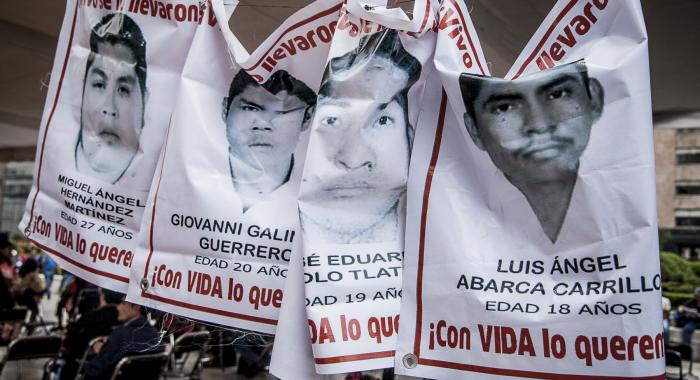Mexico city, 29 june, 2015.- Nine months after the forced disappearance of 43 education students, theplantón known as “43 x 43 por Ayotzinapa,” an occupation of the plaza of the principal museum and cultural center in the country, Bellas Artes, adjacent to the Alameda Central, began when a 3-mile march culminated at this site. This took place the day after the opening of a major exhibition of Michaelangelo and DaVinci. The cultural and political events that took place continually had a captive audience in the 10,000 people who lined up on Saturday and many more on Sunday to see the exhibit inside. Everyone was in good spirits (still angry at the government of course) in spite of a bit of rain at the beginning of the occupation on Friday and the end on Sunday, eager to participate in the revival of the movement after months of severe goverment repression and some inevitable attrition weakened the protests. (The offices of CENCOS, a movement communication organization linked to the Vatican II-era Catholic church, were raided by unidentified infiltrators just two days before Friday’s march. This is the least violent of the intimidation tactics the government and its allies have engaged in.)
The success of the weekend’s action lies in two factors: 1. Elimination of the frustration factor regarding marches that end with a couple of hours of boring or acoustically incomprehensible speeches or a series of shorter rounds of speeches at a variety of destinations. 2. As Joshua Kahn Russell and Arun Gupta point out in Beautiful Trouble: A Toolbox for Revolution: “Occupations are difficult to sustain indefinitely. Have a plan—including an exit plan.” An hour for each disappeared student turned out to be a good amount of time to sustain this marathon protest. Imagine an occupation of a strategic target—a government building, an important intersection, the Mall of America in Bloomington, Minnesota—for an hour for each black person murdered by police in the U.S. since Ferguson.
It’s important to consider that the massacre and disappearance of the students of Ayotzinapa is one of many massacres perpetrated by the government since last summer:
· Tlatlaya, Estado de México: June 30: Twentytwo people killed by the army in a small warehouse. Among the “dangerous criminals”: a 14-year-old girl shot in the back. The post-massacre manipulation of the scene was so blatant that even conservative sources like the U.S. State Department and Mexico’s in-house human rights commission have condemned this action. (This didn’t stop the U.S. from approving the sale of 18 Blackhawk helicopters and an unspecified number of all-terrain military vehicles to Mexico in recent months.)
· Iguala, Guerrero, September 26-27: Three education students and three bystanders killed immediately, 43 students disappeared and still unaccounted for.
· Mexico City, November: Three young artist- activists kidnapped in broad daylight by federal police. Two still held without charges, despite having won injunctions ordering their release.
· Apatzingán, Michoacán, January 6-7: Sixteen agricultural workers murdered and others seriously injured by federal police, accused of being gang members. Some of the surving families received bodies obviously mutilated gratuitously by the police.
· Mexico City, March 13: The MVS radio network, acceding to government pressure, fires Carmen Aristegui, one of the only independent journalists in Mexico with a top-rated program, for the second time.
· Tanhuato, Michoacán, May 22: Another extrajudicial execution by the federal police. This time, the government claims that all of the killed suspects (alleged members of the Jalisco Nueva Generación cartel) tested positive for having discharged a firearm but, curiously, they only killed one cop. Fortytwo “delinquents” and one police officer totals that number again: 43.
· February to June: Twenty-nine people killed in election-related violence around the country between the start of the campaigns in February and the elections in June. Victims include candidates of all major parties and an education student from the Universidad Nacional Pedagógica killed by federal police in Guerrero on election day.
What is the relation between this avalanche of atrocities, most planned and perpetrated by the Mexican government, and the economic and educational “reforms” it is implementing? As Naomi Klein stated in the introduction to her classic study The Shock Doctrine: The Rise of Disaster Capitalism, “Mike Battles puts it best: ‘For us, the fear and disorder offered real promise.’ The thirty-four-year-old ex-CIA operative was talking about how the chaos in postinvasion Iraq had helped his unknown and inexperienced private security firm, Custer Battles, to shake roughly $100 million in contracts out of the federal government. HIs words could serve just as well as the slogan for contemporary capitalism—fear and disorder are the catalysts for each new leap forward.”




